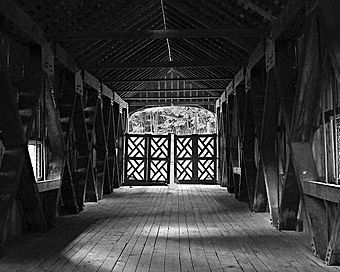Comstock's Bridge facts for kids
Quick facts for kids |
|
|
Comstock's Bridge
|
|
 |
|
| Location | Comstock Bridge Rd., East Hampton, Connecticut |
|---|---|
| Area | 1 acre (0.40 ha) |
| Built | 1840 |
| Architectural style | Howe truss covered bridge |
| NRHP reference No. | 76001978 |
| Added to NRHP | January 1, 1976 |
The Comstock's Bridge, also known as the Comstock Covered Bridge, is a special covered bridge located in East Hampton, Connecticut. It crosses the Salmon River. Built way back in 1840, it's one of only three historic covered bridges left in Connecticut. Today, people can walk across it in a small park. This amazing bridge was added to the National Register of Historic Places on January 1, 1976, which means it's an important historical site.
Contents
What is Comstock's Bridge Like?
The Comstock's Bridge is in the southeastern part of East Hampton. You can find it near where Comstock Bridge Road meets Colchester Avenue (Connecticut Route 16). This bridge is made of two main parts.
The Main Covered Part
The longest part of the bridge is 80 feet (24 m) long. It uses a special design called a Howe truss, which is a strong way to build bridges. This part has a roof shaped like a gable and its sides are covered with vertical wooden boards. The roadbed, where people used to drive, is 12 feet (3.7 m) wide. Now, gates at both ends stop cars, so only people walking can go across.
The Shorter Uncovered Part
There's also a shorter part of the bridge, about 30 feet (9.1 m) long, that connects the main bridge to the eastern riverbank. This section doesn't have a roof. Its sides are also covered with vertical wooden boards, but they have pointed tops. The parts of the bridge that rest on the ground, called abutments, are made from a mix of rough stones and cut granite.
History of Comstock's Bridge
The Comstock's Bridge was first built in 1840. It has seen a lot of history!
Early Challenges and Repairs
In the 1920s, the bridge had a big problem when a truck drove through its floor and caused a lot of damage. But don't worry, it was fixed! In the 1930s, a group called the Civilian Conservation Corps (CCC) did a lot of work to restore it. The CCC was a program during the Great Depression that helped young men find jobs. They used recycled materials from old buildings to help repair the bridge. They also added the gates at each end to protect it.
The Bridge Today
Now, the Comstock's Bridge is closed to cars and trucks. It's a peaceful place for people to visit. You can walk across it and enjoy the view from a small public park. It's a great example of old engineering and a piece of Connecticut's history.
Images for kids




